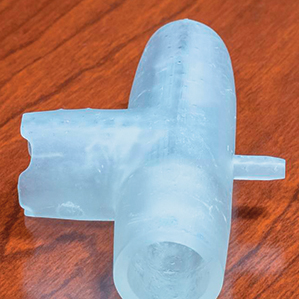
like this one, which, during the
pandemic, have converted BiPAP
machines into ventilators.
During the first surge of the COVID-19 pandemic, when personal protective equipment (PPE) supplies were low and anxiety was high, manufacturers like Ford Motor Company saw the urgent need to help and got creative. Ford used 3D printing technology to print face shields and other gear, helping keep front-line workers safe. It turns out, that was only beginning—not only of the pandemic, but also of the role 3D printing would play in meeting the unique challenges created by the pandemic. While this technology has been around for decades, its promise and potential have become newly evident.
How 3D printing is helping
3D printing is the process of creating three-dimensional objects from a digital file by adding multiple layers of a material to a single structure. In the healthcare world, it’s used to create custom guides, templates, implants and prostheses. For example, surgeons can use 3D-printed models produced from patient imaging to clarify treatment decisions and practice interventions before surgery. These anatomical models are also used in patient education—to help patients understand their condition and treatment—and in training medical students and residents.

Now, 3D printing is being used to furnish supplies for COVID-19 care. “3D printing has provided a rapid response to the changing environment,” says Sarah Michel, MBA, BSN, RN, NE-BC, former Director of Research & Clinical Engagement at HealthTrust.
When ventilators were in short supply at the height of the pandemic, one 3D-printer manufacturer obtained an emergency use authorization (EUA) from the Food and Drug Administration (FDA) for a 3D printed adapter, which turned BiPAP machines into ventilators. And when faced with a dwindling supply of nasopharyngeal swabs for use in COVID-19 testing, some healthcare facilities were able to use 3D printing to meet that demand.
Historically, most 3D printing has been outsourced, but now technology has advanced enough that in-house printing is a viable option for many hospitals. This allows for a faster turnaround time, immediate customization and—after an initial investment—a decreased individual case cost.
But because point-of-care 3D printing (done in-house at the hospital and not marketed to customers) can be done without FDA approval, there are sterilization and quality issues to mitigate.
According to a HealthTrust Physician Advisor, one limitation to incorporating 3D printing into clinical practice has been the software required to do the surgical manipulation and the design of surgical guides and models. “Previously, this was difficult to do and required the use of an engineer with one of the design companies. Now, software is available that allows the surgeon to perform this, which opens the possibilities of printing your own models and guides.”
What’s ahead
How 3D printing is used in daily practice continues to evolve. As the technology advances, more applications and use cases are being developed. In considering future applications, one HealthTrust Physician Advisor stated: “I envision machinery that can make not just resin models or forms, but also has the interchangeable tooling to process fragile biologics like nerve and cartilage, as well as custom-make metal plates and osteotomy guides and screws.”
The critical role 3D printing has played during the pandemic is another potential source of future innovation. “I think we should look at the on-demand solutions that 3D printing provided for COVID-19 as key takeaways in addressing future hospital needs,” says Michel.
Share Email COVID-19, Medical Devices, Q1 2021






